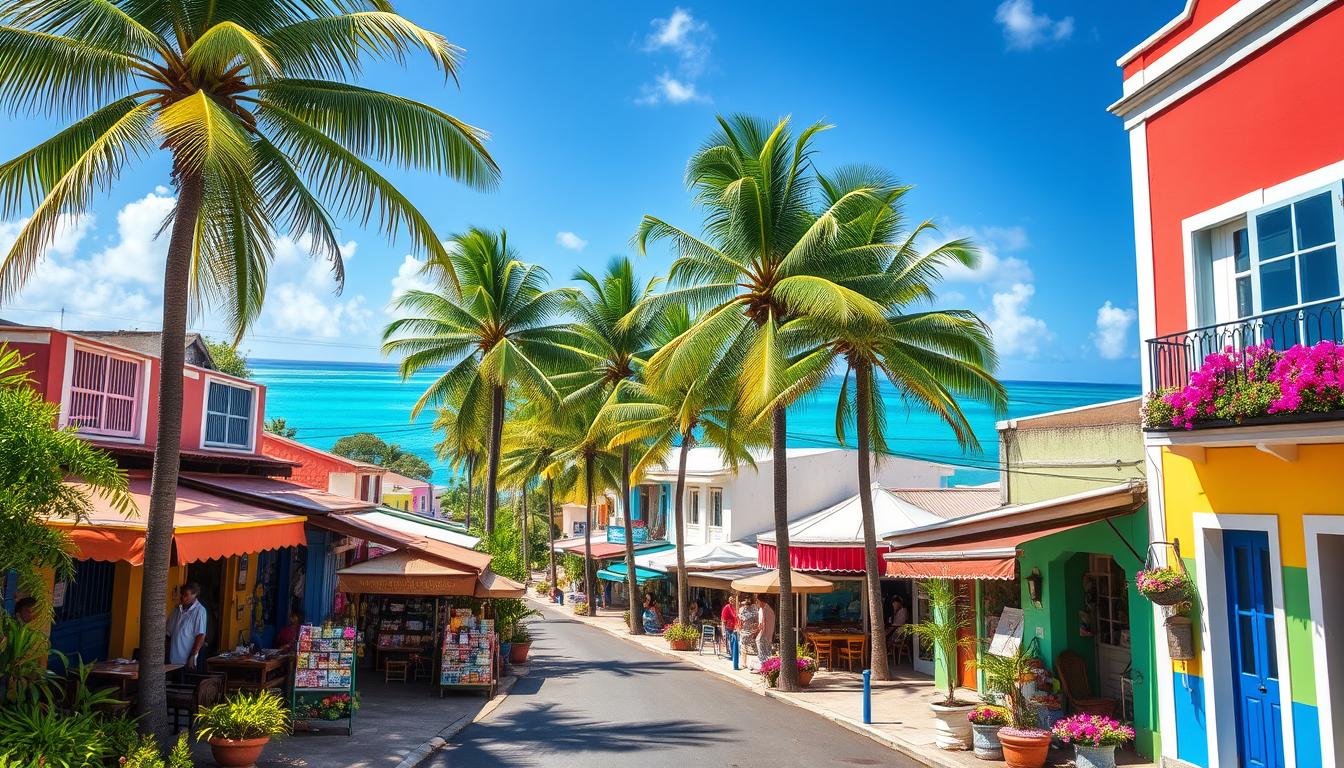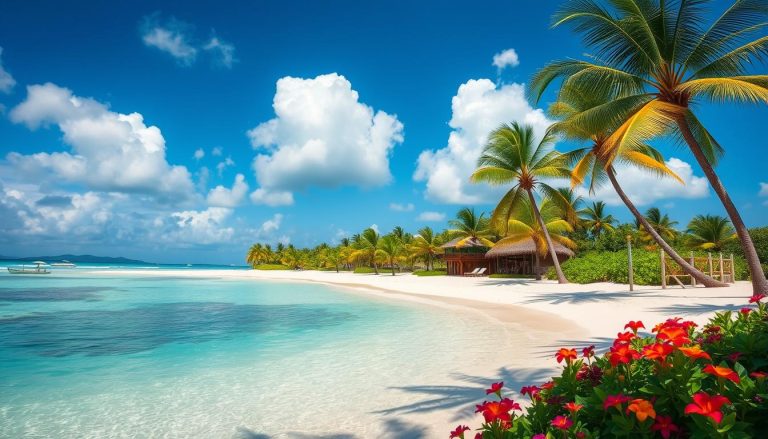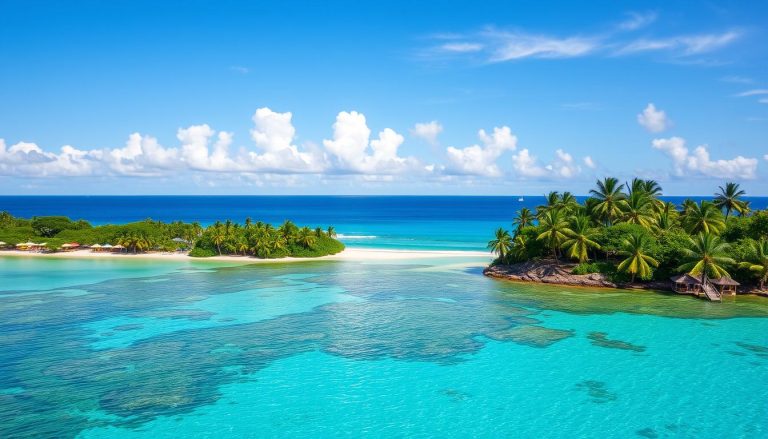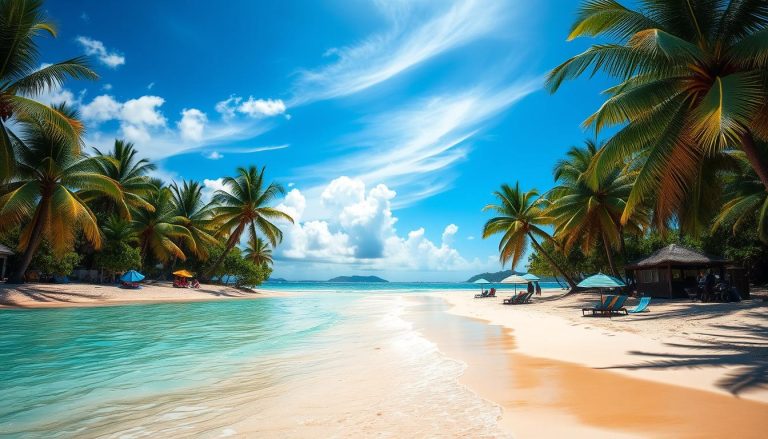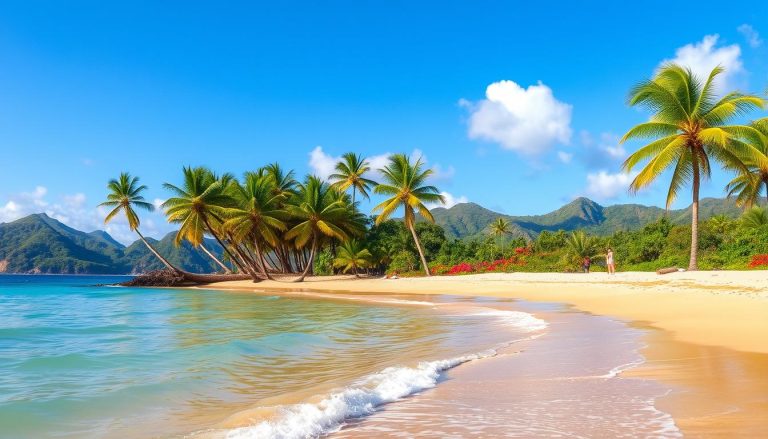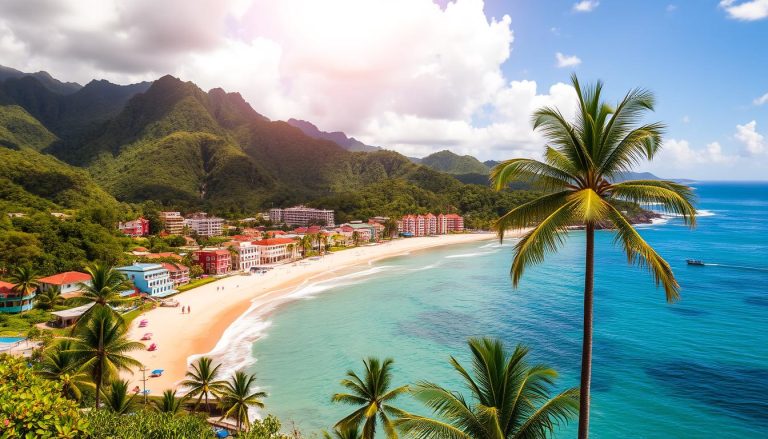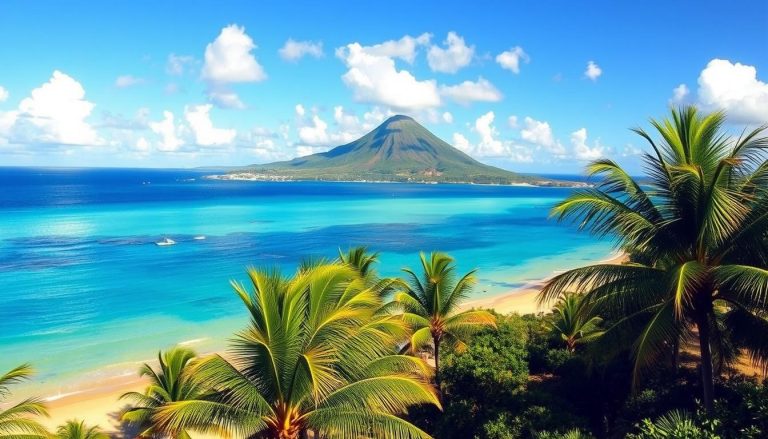Are you ready to explore the vibrant heart of the Caribbean? Welcome to Fort-de-France, Martinique’s capital. Here, history, culture, and nature come together for an unforgettable trip. From the start, you’ll be drawn into the city’s rich attractions, each showing a different side of the island.
Originally called Fort Royal, the city was founded in 1673 and renamed Fort-de-France in 1848. Now, it’s a key port and transportation center, linking Martinique to other islands. But Fort-de-France is more than a gateway. It’s a lively place filled with hidden treasures, from colonial buildings to tropical gardens.
Key Takeaways
- Discover the rich history and cultural heritage of Fort-de-France, the capital of Martinique
- Explore the city’s stunning natural attractions, including the lush Jardin de Balata botanical garden
- Immerse yourself in the local gastronomy and vibrant markets, like the Grand Marche spice market
- Uncover the architectural marvels of the city, including the Schoelcher Library and St. Louis Cathedral
- Embrace the laid-back Caribbean lifestyle and enjoy coastal activities like visiting La Francaise Beach
Discovering La Savane: The Heart of Fort-de-France
In Fort-de-France, Martinique, La Savane Gardens is a green haven. It’s a favorite spot for both locals and visitors. Here, you can find peace away from the city’s hustle.
Historical Monuments and Statues
La Savane’s lush greenery hides a white marble statue of Josephine, Napoleon’s wife. Though it lost its head in 1991, it still stands as a symbol of Martinique’s history. The park also features other monuments and statues, showing the island’s past and people’s strength.
Local Craft Markets and Vendors
Around the park, you’ll find shops and cafes that showcase local culture. Explore the craft markets for handmade items like baskets, jewelry, and woodcarvings. Each piece tells a story of Martinique’s artistic traditions.
Park Activities and Recreation
La Savane Gardens is more than a place to relax. It’s a center for community events and fun. Families, joggers, and those looking for a break all find something here. Every February, the park comes alive with the Fort-de-France carnival, attracting visitors from everywhere.
Exploring La Savane Gardens is key to experiencing Fort-de-France. You’ll see historical landmarks, local crafts, and enjoy the tropical atmosphere. This vibrant space will surely make a memorable impression.
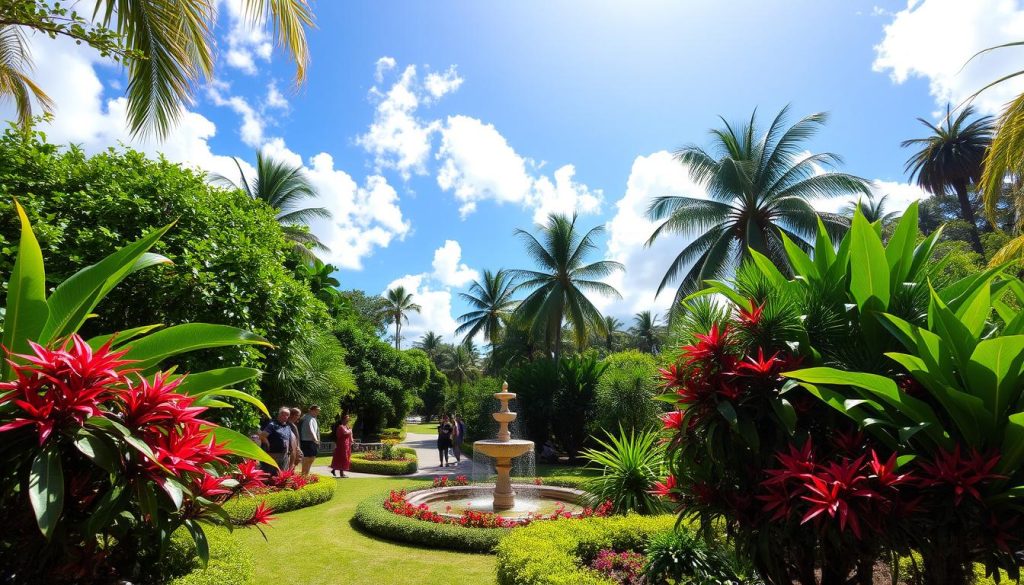
Exploring Fort Saint Louis: A Military Marvel
In the heart of Fort-de-France, Martinique, lies the impressive Fort Saint Louis. It showcases the island’s military history. Built in 1640, it protects the port and gives a peek into the Caribbean’s past.
The fort, designed in the Vauban style, sits on a rocky outcrop. It offers stunning views of the city and bay. Though some areas are off-limits, guided tours are available. They last about 75 minutes, from Tuesday to Saturday.
Visitors need to be able to walk, as the tour doesn’t support those with mobility issues. Tickets are sold at the information desk in Place de la Savane. It’s a great spot to start your Martinique fortifications tour.
“Fort Saint Louis stands as a testament to the Caribbean’s rich military history, offering a unique glimpse into the region’s strategic importance.”
For history lovers or those wanting to dive into local culture, Fort Saint Louis is a must-see. Discover the mysteries of this Caribbean military history site. You’ll appreciate Martinique’s lasting impact even more.
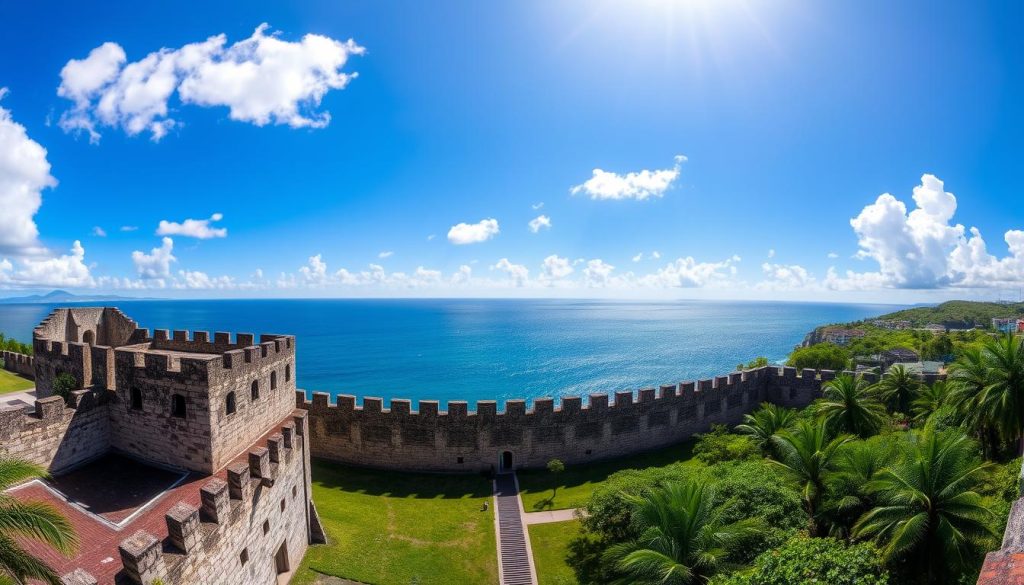
Architectural Wonders: Schoelcher Library and St. Louis Cathedral
Martinique boasts a rich architectural heritage. The capital city of Fort-de-France is home to two standout gems. The Schoelcher Library and the St. Louis Cathedral offer a glimpse into the island’s history and culture.
The Eiffel-Designed Cathedral
The St. Louis Cathedral was built in 1895. It’s the sixth church on this site, with the first from 1657. Designed by Gustave Eiffel, it has a cast iron frame and concrete walls. This makes it strong against hurricanes and earthquakes.
Its Fort-de-France architecture combines Gothic and Moorish styles. This creates a unique and captivating landmark among the Martinique historical buildings.
Historical Significance of the Library
The Schoelcher Library was built in France in 1889. Architect Henri Picq designed it. It was then dismantled and shipped to Martinique.
This architectural marvel honors Victor Schoelcher. He was key in freeing slaves in the French Caribbean. Today, the library is a testament to the island’s Caribbean cultural sites and its history.
Visiting Hours and Guidelines
Both the St. Louis Cathedral and the Schoelcher Library welcome visitors. They offer a chance to dive into the Fort-de-France architecture and learn about Martinique’s past. The Schoelcher Library is open on Monday afternoons, Tuesday through Friday all day, and Saturday mornings.
“The Schoelcher Library stands as a testament to Martinique’s rich cultural heritage and the remarkable individuals who have shaped its history.”
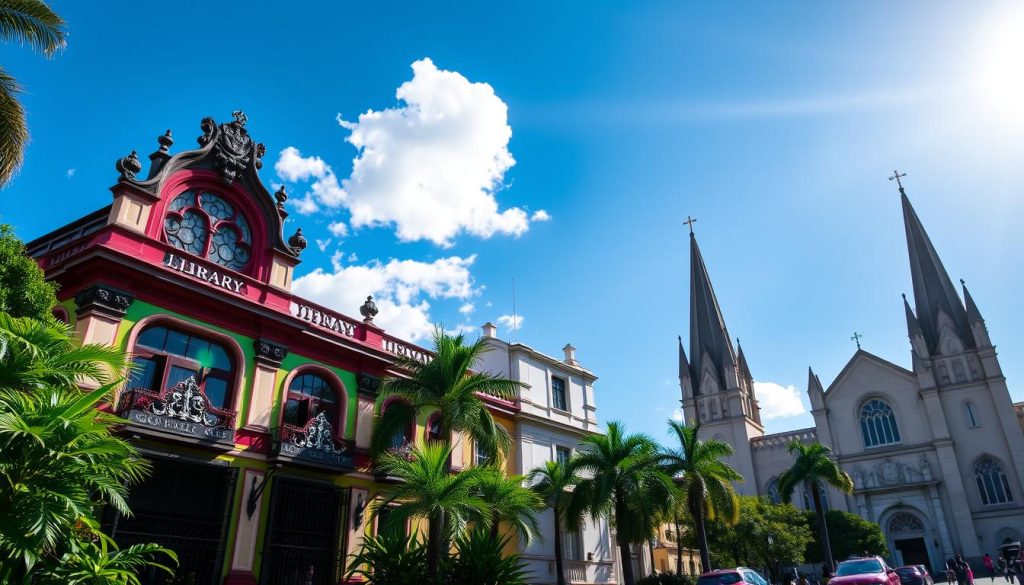
Jardin de Balata: A Tropical Paradise
Nestled just 10 kilometers from Fort-de-France, Martinique, Jardin de Balata is a stunning botanical garden. It takes you into a lush, tropical paradise. Created by poet and horticulturist Jean-Philippe Thoze, it showcases over 300 palm varieties, gathered over 20 years.
Walking along the garden’s paths, you’ll see a wide range of Caribbean plants. From tall palms to delicate ferns and bamboo, it’s a feast for the eyes. The garden’s highlight is the canopy walk, 15 meters into the bamboo forest. It gives you a bird’s-eye view of the area.
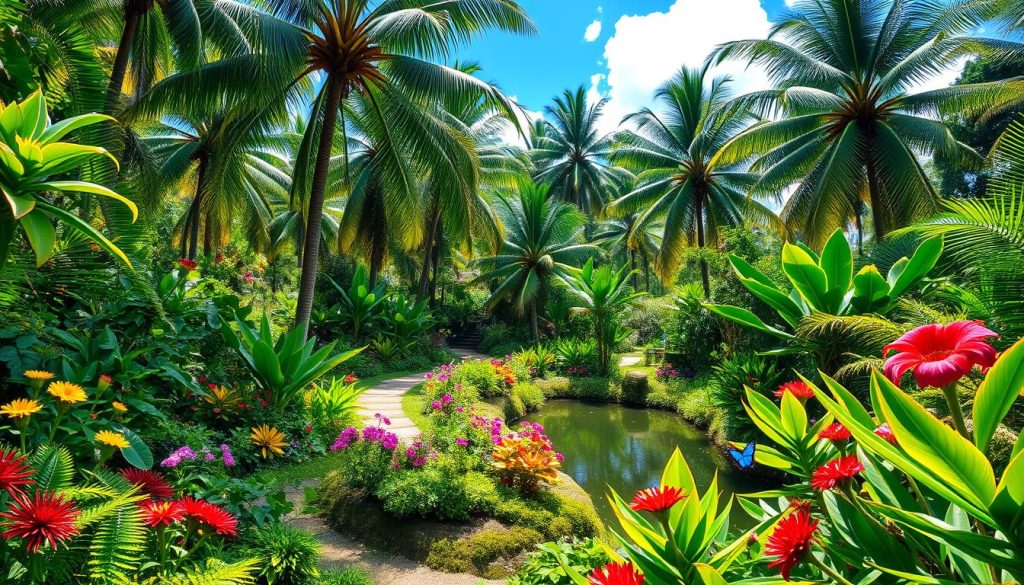
Jardin de Balata is open daily from 9 AM to 6 PM. Afternoon visits are best. Adult tickets are €16, making it a great value to see Martinique’s natural beauty.
If you love nature, exotic plants, or just need a break, Jardin de Balata is perfect. It’s a peaceful escape in Fort-de-France. Explore the wonders of Martinique’s botanical gardens, Caribbean flora, and Fort-de-France nature spots.
Cultural Heritage and Museums
Fort-de-France, the lively capital of Martinique, has many museums. They show the island’s rich history and culture. These places help us see how different cultures have influenced this Caribbean island.
Musée Departemental d'Archeologie
The Musée Departemental d’Archeologie et de Prehistoire de la Martinique is a key spot. It’s perfect for those who love learning about Martinique’s early days. The museum has many artifacts, showing life from 3000 BC to when Europeans arrived in 1635 AD.
Musée Régional d'Histoire
The Musée Régional d’Histoire et d’Ethnographie focuses on Martinique’s farming, slavery, and sugar-cane history. It’s a goldmine of knowledge. Here, you can learn about Martinique’s growth and how different cultures have shaped it.
Pre-Columbian Exhibits
- See the rich heritage of Martinique’s indigenous people through the museum’s pre-Columbian artifacts. These include pottery, stone tools, and ceremonial items.
- Find out about the Arawak and Carib tribes, who lived on the island before Europeans arrived.
- Discover how European influences changed the island’s culture forever.
These museums in Fort-de-France take you on a journey through Martinique’s history. They let visitors dive into the island’s storied past and see its diverse cultural heritage. This heritage still influences the island’s lively identity today.
Fort-de-France Walking Tours: Discovering the City's Charm
Explore the vibrant heart of Fort-de-France, Martinique’s capital, through captivating Fort-de-France guided tours. These immersive walking experiences allow you to uncover the city’s rich history and cultural heritage. They offer a unique perspective on Martinique city exploration.
The downtown walking tours, lasting about two hours, take you through key landmarks. You’ll see the Old Courthouse and the lush Caribbean urban adventures of La Savane Park. These tours provide fascinating historical insights, showing Fort-de-France’s evolution over the centuries.
For a more immersive cultural experience, try the food and culture tours. They blend historical narratives with local Creole cuisine tastings. Starting at neighborhood markets, you’ll enjoy traditional delicacies, deepening your appreciation for Martinique’s culinary heritage.
These walking tours are designed for small groups, offering a personalized and intimate experience. Discover the charm of Fort-de-France’s winding streets, charming architecture, and vibrant local life. Explore this captivating Caribbean city with your knowledgeable guide and fellow travelers.
“The walking tour of Fort-de-France was the highlight of my Martinique trip. I learned so much about the island’s history and culture, and the food tastings were simply divine.” – John Doe, Avid Traveler
| Tour Type | Duration | Highlights |
|---|---|---|
| Downtown Walking Tour | 2 hours | Old Courthouse, La Savane Park |
| Food and Culture Tour | 3 hours | Local markets, Creole cuisine tastings |
Local Gastronomy and Grand Marche Experience
Dive into Martinique’s lively food scene by visiting the Fort-de-France markets and trying the famous Creole cuisine. The Grand Marche in the city’s heart shows off the island’s flavors, from spices to traditional dishes.
Spice Market Highlights
The Grand Marche is a spice lover’s dream. You’ll find everything from columbo to madras cloth. Explore the herbs, seasonings, and even the unique Bois Bandé, a local aphrodisiac.
Traditional Creole Cuisine
Try Martinique’s famous Creole dishes. Enjoy Colombo curry and accras de morue (codfish fritters). The mix of French, African, and indigenous flavors is unforgettable.
Food Tasting Tours
Join a Caribbean food tour to see the best of Martinique’s culinary scene. These tours take you through the Grand Marche and markets. You’ll taste traditional dishes and learn about Martinique’s food history. Prices start at 56.50€, and tours are available daily except Mondays and Sundays.
“The shopping experience in Martinique combines sophistication with Caribbean charm.”
Rum Distillery Tours and Tastings
Martinique is famous for its Rhum Agricole, made from sugarcane juice. This tradition started in the mid-19th century. Back then, the refined sugar market failed, leading Martinique to create its own rum.
Today, the island has over 10 distilleries. They all follow strict AOC Martinique standards. This ensures the quality of their Rhum Agricole.
Exploring Martinique’s rum distilleries is a unique experience. You’ll learn about how rum is made and its history in the Caribbean. You’ll also get to try different Rhum Agricole styles.
Places like Saint James and Depaz show the island’s rich heritage. Saint James has a special bottle design from the 19th century. Depaz focuses on being eco-friendly, located near Mount Pelée.
| Distillery | Highlights | Tour Cost |
|---|---|---|
| Distillerie Saint-James et Musée du Rhum | Self-guided tours of the Museum of Rhum, dating back to the 18th century | Varies |
| Habitation La Salle (part of Saint James) | Collection of 17th-century buildings on the distillery grounds | Varies |
| Rhum Depaz | Environmentally-friendly farming practices, unique blue cane sugar | Varies |
| Habitation Saint-Etienne | Offers various tastings and tours | Varies |
| Habitation Clément | Rum distillery with tours and tastings | 13 euros per person |
Visiting Martinique’s distilleries is a must for rum lovers. You’ll see places like Saint James and Depaz. Each distillery gives a glimpse into the world of Martinique rum, Rhum Agricole, and Caribbean spirits.
La Francaise Beach and Coastal Activities
When you visit Fort-de-France, don’t miss La Francaise Beach. It’s close to La Savane Park and Fort Saint Louis. This urban beach is a cool spot to relax after seeing the city.
La Francaise Beach isn’t the biggest, but it’s fun. You can walk by the sea or take a boat tour. It’s a favorite for locals and tourists who love the Caribbean.
But there’s more than just the beach. La Savane Park and Fort Saint Louis are nearby. They offer a chance to dive into Martinique’s culture and nature. La Francaise Beach and these spots are perfect for your Fort-de-France trip.
